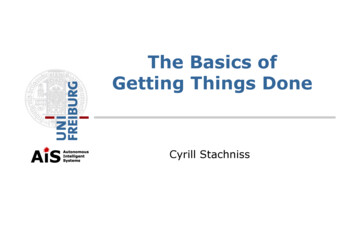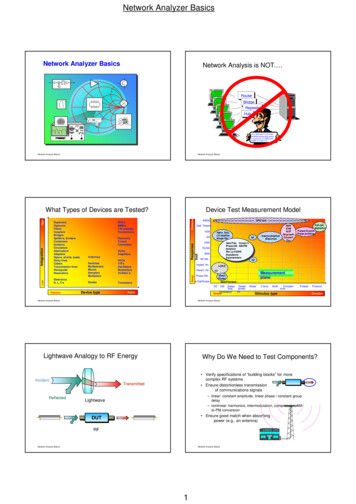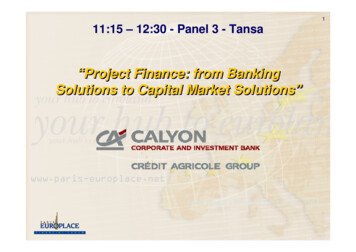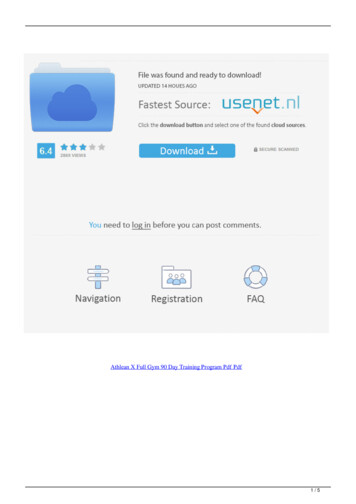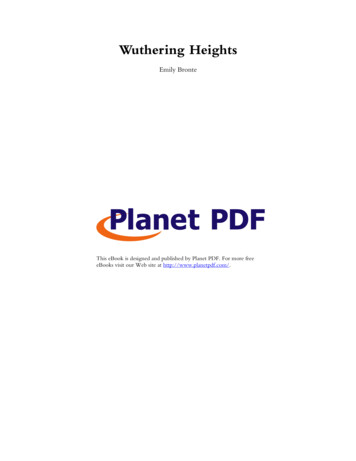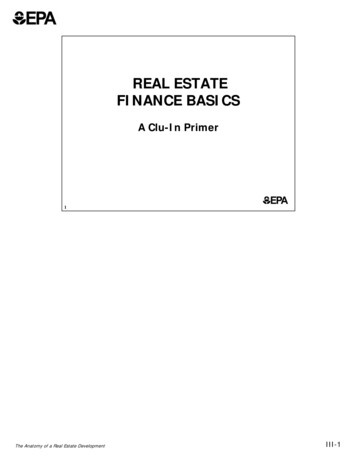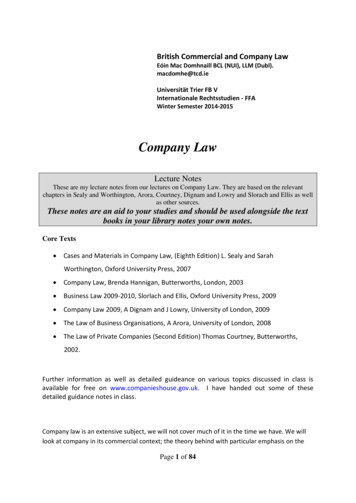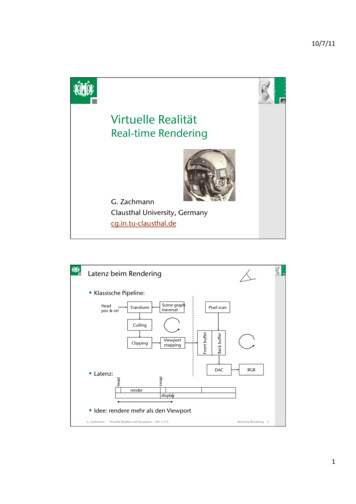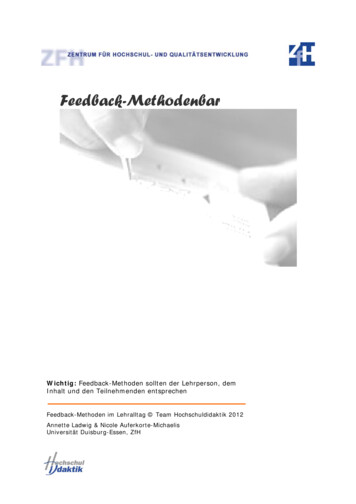
Transcription
Budapest, 2018.
CORVINUS UNIVERSITY OF BUDAPESTDEPARTMENT OF FINANCEBasics of FinanceAuthorsGábor Kürthy (Chapter 1, Chapter 2)József Varga (Chapter 3)Tamás Pesuth (Chapter 4)Ágnes Vidovics-Dancs (Chapter 5.1 - 5.3)Ildikó Gelányi (Chapter 5.4)Géza Sebestyén (Chapter 5.5)Eszter Boros (Chapter 6)Gábor Sztanó (Chapter 7)Erzsébet Varga (Chapter 8)EditorGábor KürthyReviewersÁgnes Vidovics-Dancs (Chapter 1)György Surányi (Chapter 2)Gábor Kürthy (Chapters 3, 4, 5, 6, 7, 8)Budapest, 2018.ISBN 978-963-503-743-82
TABLE OF CONTENTSChapter 1 Technical introduction. 4Chapter 2 Money and Banking from a Historical and Theoretical Perspective . 72.1 Money in history and theory .72.2 Production of money and creation of money .92.3 Fiat money. 182.4 Modern monetary systems.24Bibliography .32Chapter 3 Banking Operations.333.1 Passive banking oparations .333.2 Active banking operations .36Chapter 4 Banking Risks and Regulation .394.1 Financial intermediation .394.2 The role of banks and the different types of banking .394.3 Risks faced by banks . 404.4 Banking regulation.43Bibliography .47Chapter 5 Securities Markets . 485.1. Basic terms .485.2. Bond markets .495.3. Credit rating .505.4 Stock exchanges .525.5 Derivatives . 57Bibliography .61Chapter 6 The Balance of Payments . 626.1 Purpose of the BoP.626.2 Basic Definitions and Principles .636.3 Constructing the BoP Step by Step .656.4 Concluding remarks .70Bibliography .71Chapter 7 Foreign Exchange Markets.727.1 Introduction to FX-markets .727.2 FX markets: demand and supply . 737.3 Exchange-rate theories .747.4 Exchange-rate systems .75Chapter 8 Public Finance and Taxation.798.1 The economic functions of the government . 798.2 Revenues of the Government.823
CHAPTER 1 TECHNICAL INTRODUCTIONTo understand finance properly, one needs to have a solid grasp on the elementaldefinitions and techniques of accounting. For being able to keep track of the followingchapters, we suggest the Reader studying the next few pages thoroughly.The balance sheet is a financial statement that represents an economic agent’s (ahousehold, a company, a bank, a budgetary institution etc.) wealth by two approaches.Assets are listed on the left-hand side or asset side, resources financing the assets arelisted on the right-hand side or liability-equity side. The balance sheet is always inbalance, that is:ASSETS LIABILITIES EQUITYWhen constructing the balance sheet, assets are listed first, then liabilities. Shareholders’equity is always a residual, i.e. it is the difference between assets and liabilities. Theequity of a company or a bank is frequently referred to as capital, which can lead tomisunderstandings. In this context, capital is not a pile of cash that can be invested. It isonly a notional entry that shows what would be left if all the company’s debts wererepaid. A negative book value of the capital means that the company is insolvent in thelong run, i.e. it cannot repay all of its liabilities.Example: the balance sheet of a companyCompany “ABC” has 57,000 EUR worth of assets that are partially financed by long- andshort-term liabilities. Long-term (or non-current) liabilities - such as bonds issued or mortgages- are due over 12 months. Short-term (or current) liabilities - such as bills or taxes payable mature within 12 months.ABC Company, Balance sheet, at 31-Dec-2017Assets (EUR)Liabilities (EUR)Land25,000Long-term liabilities15,000Machinery20,000Short-term liabilities3,000Inventories4,000SuppliesEquity (EUR)39,0006,000Cash2,000Total assets:57,000Total liabilities and equity: 57,000Economic events can change the balance sheet in four ways: both sides increase by the same amountboth sides decrease by the same amountthe asset side is restructured, i.e. some assets increase and others decreasethe liability-equity side is restructured, i.e. some liabilities or equity items increase andothers decrease4
The following example helps to understand the issues described above.Example: bookkeepingIn the first month of 2018, the following events happened to ABC company: 1,000 EUR worth of inventories were bought, the company promised the supplier to pay in60 days.Assets:Inventories, 1,000 EURLiabilities: Short-term liabilities, 1,000 EUREquity:no change 1,500 EUR worth of goods were sold for 1,900 EUR.Assets:Supply -1,500 EURLiabilities:no changeCash, 1,900 EUREquity: 400 EUR The company repaid 400 EUR short-term loan and 20 EUR interest.Assets:Cash -420 EURLiabilities:Short-term liabilities -400 EUREquity: - 20 EUR The National Competition Authority imposed a fine of 500 EUR on the company, to be paidwithin 6 months.Assets:no changeLiabilities:Short-term liabilities, 500 EUREquity: -500 EUR An investment bank granted the company 5,000 EUR worth of loan with the maturity of 20years. The company spent the proceeds on a new machinery.Assets:Machinery, 5,000 EURLiabilities: Long-term liabilities, 5,000 EUREquity:no changeIn order to keep the balance, we followed the rules of double entry bookkeeping. At the end ofJanuary-2018, after booking all the events, the balance sheet looks like as follows:ABC Company, Balance sheet, at 31-Jan-2018Assets (EUR)Liabilities (EUR)Land25,000Long-term liabilities20,000Machinery25,000Short-term 80Total assets:62,980Equity (EUR)38,880Total liabilities and equity: 62,980Economic events, mostly exchanges, always happen to two agents simultaneously, whichleads to quadruple entry bookkeeping on the systemic level. If “A” does business with “B”then two changes arise in both balance sheets, which means four changes altogether. (InLatin, four is quattuor, that is where the term comes from.) Consider the followingexamples.5
Example: quadruple entry bookkeeping Company “X” buys inventories from company “Y” and pays 4,000 EUR for them. Before thetransaction, the book value of the traded inventories was 3,500 EUR.Company “X”Company “Y”Inventories 4,000Supply -3,500Bank account -4,000Bank account 4,000Equity 500 Company “Z” pays 2,000 EUR wage to Mrs. M.Company “Z”Bank account -2,000Mrs. M.Bank account 2,000Equity -2,000Equity 2,000 Mr. Q. repays 100 EUR of debt plus 5 EUR interest to Mrs. S. in cash.Mr. Q.Cash -105Mrs.S.Liabilities -100Claims -100Equity -5Cash 105Equity 5From an accounting point of view, there are two kinds of goods. Real economic goodsare on the asset side of one single balance sheet, while financial goods appear in twobalance sheets simultaneously: on the asset side of one balance sheet and on the liabilityequity side of another one. A slice of bread or a bicycle are real economic goods; amortgage loan, a commercial bill or a share are financial goods.Financial goods on the liability-equity side are obligations, while those on the asset sideare claims. A commercial bill with the nominal value of 500 EUR is a claim to its ownerand an obligation for its issuer. The issuer is legally bound to pay 500 EUR when the billmatures. In case of default - i.e. if the issuer is not able or not willing to pay -, the ownerof the bill can sue the issuer.Shares might be regarded as financial assets too, although in this case the issuer is notlegally bound to pay any money. Shares are rather economic than legal promises to paydividends or provide capital gains through the appreciation of their price. Disappointedowners - in case of no dividend payments and no price increase - can punish the issuercompany on the market by selling the shares. What happens if investors start selling theshares of some company en masse? The price of the shares plummets which leads to thesimultaneous devaluation of the assets of the company. (Remember, the value of theassets always has to be equal to the summed value of the liabilities and the equity. Aprice drop of shares devalues equity and assets simultaneously.) As assets are collateralbehind the liabilities, a significant drop in their value can lead to financial difficulties.6
CHAPTER 2 MONEY AND BANKING FROM A HISTORICAL AND THEORETICAL PERSPECTIVE2.1 Money in history and theoryThe historical emergence of money can be related to the emergence of market-basedeconomies. For thousands of years, communities were organised by redistributiveinstitutions, centralised rules coordinated production, consumption, investment, etc.Ancient Egypt and Babylonia are the most typical examples of redistributive empires, buteven in the feudalistic European kingdoms, markets played only a minor role for a longtime. (Polányi, 1944: Chapter 4) These markets are frequently described as places whererural farmers and urban manufacturers exchanged their products directly. However, it iseasy to see that barter is a very inefficient way of exchange, as the probability of doublecoincident of wants is low and by the growth of the number of market participants, it getseven lower. There is no historical proof that direct barter has ever played an important rolein coordinating markets (Wray, 1993). Since the very advent of locally organised markets,buyers and sellers have been using a commonly accepted specific good as the mediumof exchange. Primitive forms of money had been used before as store of value andstandard of deferred payments, but in lack of markets, they have not functioned as themedium of exchange or the measure of value (Polányi, 1957). The most importantfunction of ancient coins was probably the fact that the state (the king or the queen)accepted them when paying the taxes. This characteristic made primitive moneygenerally acceptable on markets: as everyone had to pay taxes, sellers accepted coinsbecause they knew they could (and in most cases, they should!) use them for taxpayment, and they knew that other sellers from whom they would buy goods werethinking in the same way. It is tautological, but money is accepted because it is thought tobe accepted.From this short introduction it has to be clear that money is defined by its functions, i.e.we call something money if it is a medium of exchange, standard of deferred payments, store of value, measure of value.Money as a means of exchange helps market-coordination in several dimensions. Asmentioned above, general acceptance simplifies trade by splitting long and harddiscoverable chains of exchanges into small parts. Without money, theoretically, theeconomy as a whole must find the market-clearing exchanges simultaneously to avoiddisequilibrium. This cannot be implemented without the knowledge of some centralplanner, who, of course, does not exist. Besides, the use of money spares information: ina barter economy with N kinds of goods, the number of relative prices that marketparticipants have to remember isN*(N 1), whereas in an economy with N kinds of27
goods and money, the number of absolute prices is N . Ifinformation set is 4,950 and 100 in the two cases respectively.N 100 , the size of theIn a monetised economy, debt is easy to measure an
Basics of Finance Authors Gábor Kürthy (Chapter 1, Chapter 2) József Varga (Chapter 3) Tamás Pesuth (Chapter 4) Ágnes Vidovics-Dancs (Chapter 5.1 - 5.3) Ildikó Gelányi (Chapter 5.4) Géza Sebestyén (Chapter 5.5) Eszter Boros (Chapter 6) Gábor Sztanó (Chapter 7) Erzsébet Varga (Chapter 8) Editor Gábor Kürthy Reviewers Ágnes Vidovics-Dancs (Chapter 1) György Surányi (Chapter 2 .
